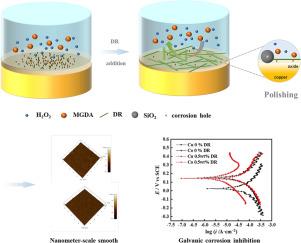A design of green slurry for copper/cobalt barrier-step chemical mechanical polishing with controlled removal selectivity and dynamic galvanic corrosion inhibition
IF 8.3
2区 材料科学
Q1 MATERIALS SCIENCE, MULTIDISCIPLINARY
引用次数: 0
Abstract
Chemical mechanical polishing (CMP) is one critical process in chip fabrication while also regarded as highly polluting due to the toxic CMP slurries. Though green slurries were recently proposed and developed, few of them could satisfy the stringent requirements of the simultaneous planarization of copper/cobalt heterogeneous structure, especially in technology node below 14 nm. In this contribution, a green CMP slurry with a biodegradable chelator methylglycinediacetic acid (MGDA) and a plant-extract inhibitor disproportionated rosin (DR) was designed. Nanometer-scale smooth surface, removal selectivity, galvanic corrosion inhibition and residual control was realized with the developed slurry. Through comprehensive experiments and theoretical calculations, the roles of the ingredients played and their synergistic material removal mechanism were elucidated. MGDA partially dissolved the oxide film, especially Cu(OH)2 formed by H2O2 and the porous film could be more easily removed by the mechanical friction of abrasive particles. DR ensured post-polished surface quality by inhibiting over-corrosion through adsorption on copper surface. Density-functional-theory calculations analyzed DR's molecular reactivity and determined the most stable parallel adsorption configuration. The work provides useful insights into the fundamental interactions of components in CMP process. In addition, both MGDA and DR are commercially available with low cost, showing great practical application prospect in low-technology-node chip fabrication.

具有可控去除选择性和动态电化学腐蚀抑制作用的铜/钴阻挡层化学机械抛光绿色浆料设计
化学机械抛光(CMP)是芯片制造中的一项关键工艺,同时也因有毒的 CMP 研磨液而被视为高污染工艺。虽然最近有人提出并开发了绿色浆料,但很少有浆料能满足铜/钴异质结构同时平面化的严格要求,尤其是在 14 纳米以下的技术节点。本文设计了一种含有可生物降解螯合剂甲基乙二酸(MGDA)和植物提取物抑制剂歧化松香(DR)的绿色 CMP 泥浆。所开发的泥浆实现了纳米级的光滑表面、去除选择性、电化学缓蚀和残留控制。通过综合实验和理论计算,阐明了各成分的作用及其协同去除材料的机理。MGDA 部分溶解了氧化膜,尤其是 H2O2 形成的 Cu(OH)2,多孔膜在磨料颗粒的机械摩擦下更容易去除。DR 通过吸附在铜表面,抑制过度腐蚀,从而确保抛光后的表面质量。密度-官能团理论计算分析了 DR 的分子反应性,并确定了最稳定的平行吸附构型。这项工作为深入了解 CMP 工艺中各成分的基本相互作用提供了有益的启示。此外,MGDA 和 DR 均可在市场上买到,且成本低廉,在低技术节点芯片制造中具有广阔的实际应用前景。
本文章由计算机程序翻译,如有差异,请以英文原文为准。
求助全文
约1分钟内获得全文
求助全文
来源期刊

ACS Applied Materials & Interfaces
工程技术-材料科学:综合
CiteScore
16.00
自引率
6.30%
发文量
4978
审稿时长
1.8 months
期刊介绍:
ACS Applied Materials & Interfaces is a leading interdisciplinary journal that brings together chemists, engineers, physicists, and biologists to explore the development and utilization of newly-discovered materials and interfacial processes for specific applications. Our journal has experienced remarkable growth since its establishment in 2009, both in terms of the number of articles published and the impact of the research showcased. We are proud to foster a truly global community, with the majority of published articles originating from outside the United States, reflecting the rapid growth of applied research worldwide.
 求助内容:
求助内容: 应助结果提醒方式:
应助结果提醒方式:


